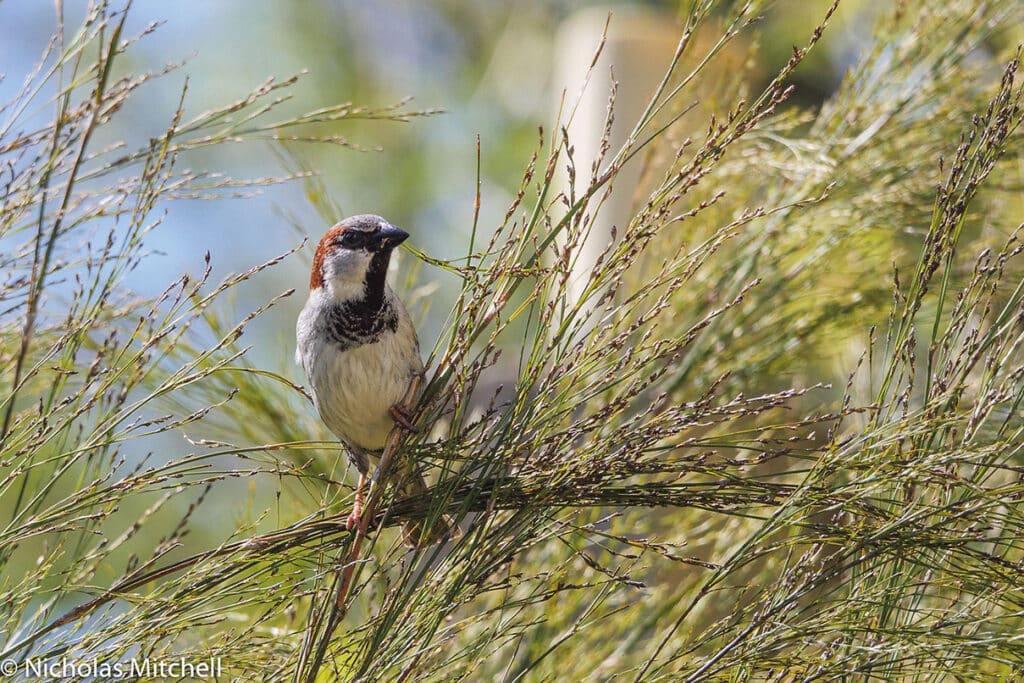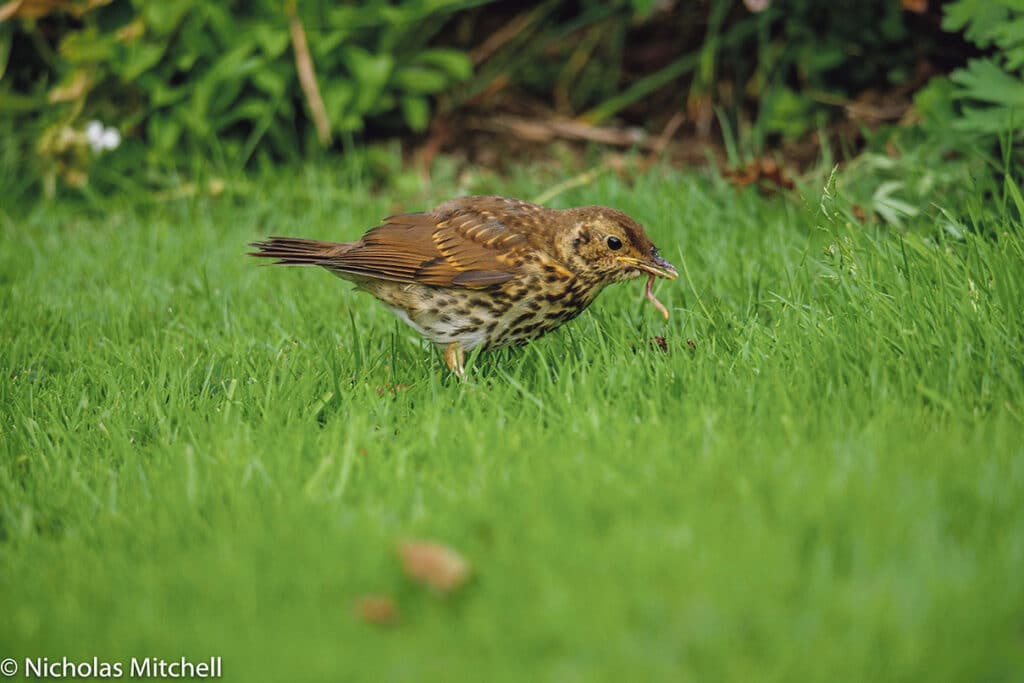There’s a lot we can do now to make our gardens more welcoming to overwintering birds says Nicholas Mitchell, Birdwatch Ireland West Cork.

Male House Sparrow collecting nesting material from a Cape Restio 
Juvenile Song Thrush feeding on the lawn
August is over and some of our summer visitors, such as the Common Swift, have already left their breeding sites in West Cork for their winter grounds. On average, it can take a Swift up to ten weeks to get to sub-Saharan West Africa, of which about six of those weeks will be stopovers or delays. It will be May next year before we see them again. Over the last few weeks of August, you may also have noticed large numbers of (Barn) Swallows chattering and swooping above your garden feeding on insects. They need to accumulate fat and body reserves necessary to sustain them on their flight southward.
The headlands on the West Cork coast are also on the route of birds that spent the summer further north and are now migrating south. These next two months are a great time to visit one of these peninsulas, such as the Mizen, to witness the migration as songbirds make their way along ditches and hedgerows until the land meets the sea and they head for the next landfall. A bird that we generally only see here during the autumn migration is the ‘Greenland’ race of the (Northern) Wheatear that breeds in far north-eastern Canada. It stops here having flown across the Atlantic before turning right to Africa. It may only take four days to cross the Atlantic and in order to fuel its flight it accumulates so much fat that it nearly doubles its normal body weight. The Branch runs outings at this time of year specifically for the autumn migration so, if you are interested, subscribe to our mailing list (details below).
While the migration is underway, there are also a few jobs that can be done in your garden to prepare for autumn and winter. Although some garden songbirds will be migrating south, there will also be the arrival of winter visitors. A good example is the Robin, which migrates from Scandinavia, northern Europe and Russia in the autumn. These birds will spend the winter here, although I once heard tell that it’s only the males that stay here to defend their territories and the female Robins fly further south to spend the winter in Portugal. I hope that’s true!
The first task is to get the bird feeders ready. Whether or not you fed the birds throughout the summer, this is a good time to clean your feeders before putting them out for the autumn and winter. Ideally, situate your feeders near some cover, and where the birds have a clear view of any approaching predators, but also where you can see them. Fill your feeders with a high-quality seed mix bought from a reputable supplier and, if you want to attract a greater range of species, augment this with suet cakes, mealworms, and fat balls etc. A supply of water is also vitally important, not just for drinking but for bathing and cleaning. Finally, clean your feeders with warm soapy water regularly to minimise the spread of disease. Moving your feeders to different parts of the garden from time to time will also stop the build-up of bird droppings and discarded seed.
Another thing that you can do to provide food for your garden birds is to create habitats for insects by leaving areas with leaves on the ground and not pruning branches until closer to spring. You could also grow plants such as teasel, holly, ivy, hawthorn and cotoneaster; something to think about when making plans for your garden over the winter months.
The next task is to clean your bird boxes. Most garden birds will have finished nesting by the end of August, so September is a good time to clean your nest boxes. However, before taking the boxes down, make sure that the nest is no longer active! Remove and dispose of any unhatched eggs and any nesting material first. Then give the inside of the box a good brush. Next, pour boiling water over the box to kill any remaining parasites. Do not use any insecticides or flea powders. Let the box dry thoroughly before putting it back. If you put a small amount of clean hay or wood shavings in the box then birds may use it during the winter as a roost site. Do not use straw. If you do not have any nest boxes, then this could either be a winter project or, dare I utter the word so early in the year, a Christmas present.
Providing food, shelter and habitat for birds and wildlife in your garden is not just good for them but also for your own well-being and enjoyment, whether it is from watching House Sparrows collecting nesting material in the spring or a recently fledged Song Thrush feeding on the lawn in late summer.
For more information about the BirdWatch Ireland West Cork Branch contact Nicholas Mitchell at secretary@birdwatchirelandwestcork.ie or join our mailing list by sending an email to mailinglist@birdwatchirelandwestcork.ie.


